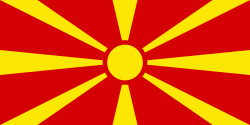Lukovo (Lukovo)
Lukovo is a village in Struga Municipality, in North Macedonia. It was a seat of Lukovo Municipality until 2004.
Latinski Dabje is the name of a nearby mountain in Lukovo. It takes its name from Latini which in the Middle Ages was used by Slavic and Aromanian Orthodox communities to refer to Catholic Albanians. The presence of the toponym suggests either direct linguistic contact with Albanians or the former presence of Catholic Albanians in the area of Lukovo.
Lukovo is attested in the Ottoman defter of 1467 as a village in the timar of Saadi Hoca in the vilayet of Dulgoberda. The settlement had a total of 11 households and the anthroponymy recorded depicts a predominantly Slavic character, although Albanian personal names are also attested (e.g., Gjergj Brateshi), alluding to Albanian-Slavic cohabitation or symbiosis. A certain Todec from Çermenika appears among the household heads.
Latinski Dabje is the name of a nearby mountain in Lukovo. It takes its name from Latini which in the Middle Ages was used by Slavic and Aromanian Orthodox communities to refer to Catholic Albanians. The presence of the toponym suggests either direct linguistic contact with Albanians or the former presence of Catholic Albanians in the area of Lukovo.
Lukovo is attested in the Ottoman defter of 1467 as a village in the timar of Saadi Hoca in the vilayet of Dulgoberda. The settlement had a total of 11 households and the anthroponymy recorded depicts a predominantly Slavic character, although Albanian personal names are also attested (e.g., Gjergj Brateshi), alluding to Albanian-Slavic cohabitation or symbiosis. A certain Todec from Çermenika appears among the household heads.
Map - Lukovo (Lukovo)
Map
Country - Republic_of_Macedonia
 |
 |
The region's history begins with the kingdom of Paeonia, a mixed Thraco-Illyrian polity. In the late sixth century BC, the area was subjugated by the Persian Achaemenid Empire, then incorporated into the Kingdom of Macedonia in the fourth century BC. The Roman Republic conquered the region in the second century BC and made it part of the larger province of Macedonia. The area remained part of the Byzantine Empire, but was often raided and settled by Slavic tribes beginning in the sixth century of the Christian era. Following centuries of contention between the Bulgarian, Byzantine, and Serbian Empires, it was part of the Ottoman Empire from the mid-14th until the early 20th century, when, following the Balkan Wars of 1912 and 1913, the modern territory of North Macedonia came under Serbian rule.
Currency / Language
| ISO | Currency | Symbol | Significant figures |
|---|---|---|---|
| MKD | Macedonian denar | ден | 2 |
| ISO | Language |
|---|---|
| SQ | Albanian language |
| MK | Macedonian language |
| SR | Serbian language |
| TR | Turkish language |















